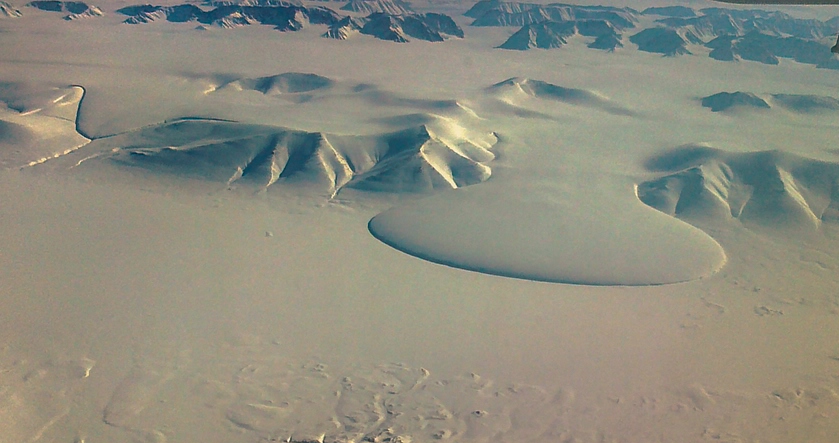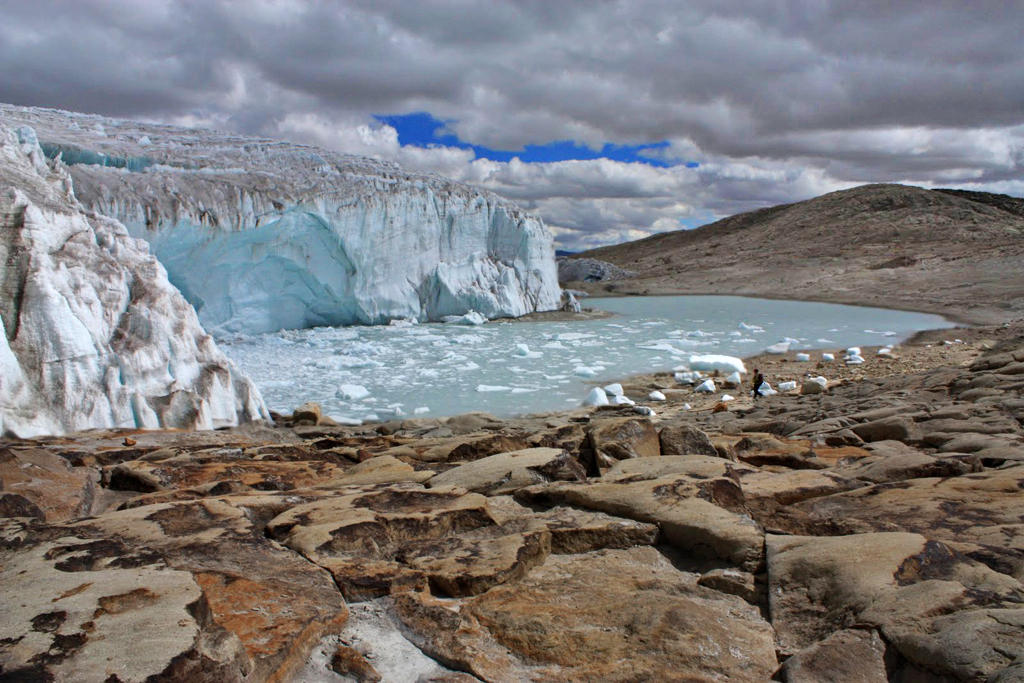|
Princess Elizabeth Alps
The Princess Elizabeth Alps ( da, Prinsesse Elisabeth Alper) is a mountain range in King Frederick VIII Land, northeastern Greenland. Administratively this range is part of the Northeast Greenland National Park zone. The range was named by Eigil Nielsen during the 1938–39 Mørkefjord Expedition after Princess Elisabeth of Denmark (1935–2018), daughter of Prince Knud. Geography The Princess Elizabeth Alps run roughly from north to south across the western half of the large Crown Prince Christian Land peninsula with an average elevation of . The range begins abruptly at the Ingolf Fjord in the south, with the mountains rising steeply from the shore. Towards the northern end the elevations decrease until the range becomes a chain of small nunataks barely rising above the surrounding ice sheet. Google Earth The area of the range is bounded in the north by the Flade Isblink, a massive ice sheet, to the west by the Nunataami Elv valley, to the south by the Ingolf Fjord, a ... [...More Info...] [...Related Items...] OR: [Wikipedia] [Google] [Baidu] |
Romer Lake
Romer Lake ( da, Romer Sø) is a land-locked freshwater fjord at the northern end of King Frederick VIII Land, near Greenland's northeastern coast. The Danish military base/weather station Nord —the only inhabited place in the area— lies to the northeast. The lake and its surroundings are part of the Northeast Greenland National Park zone. Romer Lake was first mapped in 1933 by Lauge Koch during aerial surveys made during the 1931–34 Three-year Expedition to East Greenland ''(Treårsekspeditionen)''. It was likely named after the Danish Astronomer/Inventor Ole Rømer (1644–1710). Geography Romer Lake is located at the western end of the Crown Prince Christian Land peninsula to the west of the Princess Elizabeth Alps. It lies in long and narrow depression running parallel to the Denmark Fjord system further north and stretching roughly from NE to SW for about . A glacier has its terminus at the northern end and the Nunataami Elv river valley flows out of the souther ... [...More Info...] [...Related Items...] OR: [Wikipedia] [Google] [Baidu] |
Arctic
The Arctic ( or ) is a polar region located at the northernmost part of Earth. The Arctic consists of the Arctic Ocean, adjacent seas, and parts of Canada ( Yukon, Northwest Territories, Nunavut), Danish Realm ( Greenland), Finland, Iceland, Norway, Russia ( Murmansk, Siberia, Nenets Okrug, Novaya Zemlya), Sweden and the United States ( Alaska). Land within the Arctic region has seasonally varying snow and ice cover, with predominantly treeless permafrost (permanently frozen underground ice) containing tundra. Arctic seas contain seasonal sea ice in many places. The Arctic region is a unique area among Earth's ecosystems. The cultures in the region and the Arctic indigenous peoples have adapted to its cold and extreme conditions. Life in the Arctic includes zooplankton and phytoplankton, fish and marine mammals, birds, land animals, plants and human societies. Arctic land is bordered by the subarctic. Definition and etymology The word Arctic comes from the Greek w ... [...More Info...] [...Related Items...] OR: [Wikipedia] [Google] [Baidu] |
Glacier
A glacier (; ) is a persistent body of dense ice that is constantly moving under its own weight. A glacier forms where the accumulation of snow exceeds its ablation over many years, often centuries. It acquires distinguishing features, such as crevasses and seracs, as it slowly flows and deforms under stresses induced by its weight. As it moves, it abrades rock and debris from its substrate to create landforms such as cirques, moraines, or fjords. Although a glacier may flow into a body of water, it forms only on land and is distinct from the much thinner sea ice and lake ice that form on the surface of bodies of water. On Earth, 99% of glacial ice is contained within vast ice sheets (also known as "continental glaciers") in the polar regions, but glaciers may be found in mountain ranges on every continent other than the Australian mainland, including Oceania's high-latitude oceanic island countries such as New Zealand. Between latitudes 35°N and 35°S, glaciers occur ... [...More Info...] [...Related Items...] OR: [Wikipedia] [Google] [Baidu] |
Glaciated
A glacier (; ) is a persistent body of dense ice that is constantly moving under its own weight. A glacier forms where the accumulation of snow exceeds its ablation over many years, often centuries. It acquires distinguishing features, such as crevasses and seracs, as it slowly flows and deforms under stresses induced by its weight. As it moves, it abrades rock and debris from its substrate to create landforms such as cirques, moraines, or fjords. Although a glacier may flow into a body of water, it forms only on land and is distinct from the much thinner sea ice and lake ice that form on the surface of bodies of water. On Earth, 99% of glacial ice is contained within vast ice sheets (also known as "continental glaciers") in the polar regions, but glaciers may be found in mountain ranges on every continent other than the Australian mainland, including Oceania's high-latitude oceanic island countries such as New Zealand. Between latitudes 35°N and 35°S, glaciers occur only i ... [...More Info...] [...Related Items...] OR: [Wikipedia] [Google] [Baidu] |
North Greenland Section-txu-pclmaps-oclc-8322829 A 1
North is one of the four compass points or cardinal directions. It is the opposite of south and is perpendicular to east and west. ''North'' is a noun, adjective, or adverb indicating direction or geography. Etymology The word ''north'' is related to the Old High German ''nord'', both descending from the Proto-Indo-European unit *''ner-'', meaning "left; below" as north is to left when facing the rising sun. Similarly, the other cardinal directions are also related to the sun's position. The Latin word ''borealis'' comes from the Greek '' boreas'' "north wind, north", which, according to Ovid, was personified as the wind-god Boreas, the father of Calais and Zetes. ''Septentrionalis'' is from ''septentriones'', "the seven plow oxen", a name of ''Ursa Major''. The Greek ἀρκτικός (''arktikós'') is named for the same constellation, and is the source of the English word ''Arctic''. Other languages have other derivations. For example, in Lezgian, ''kefer'' can mean bo ... [...More Info...] [...Related Items...] OR: [Wikipedia] [Google] [Baidu] |
Nord, Greenland
Station Nord is a military and scientific station in northeastern Greenland 1700 km north of the Arctic Circle. It is about from the geographic North Pole, on Princess Ingeborg Peninsula ( da, Prinsesse Ingeborg Halvø) in northern Kronprins Christian Land, making it the second northernmost permanent settlement and base of the Northeast Greenland National Park and of Greenland as a whole (two stations in Peary Land further north, Brønlundhus and Kap Harald Moltke, are not permanently occupied). The Danish Defense Command base is staffed by five Danish non-commissioned officers on a 26-month tour of duty; accommodation is also available for over twenty scientists and other personnel during the summer months. The station has about 35 buildings. It is not accessible by ship; ice conditions would permit a passage only every five to ten years. The name ''Nord'' simply means "north" in Danish. Winter darkness extends from 15 October to 28 February. History Joint U.S ... [...More Info...] [...Related Items...] OR: [Wikipedia] [Google] [Baidu] |
Holm Land
Holm Land ( da, Holms Land), sometimes referred to as "Hahn Land", is a peninsula in King Frederick VIII Land, northeastern Greenland. Administratively it belongs to the NE Greenland National Park area. This peninsula was named by the 1906-1908 Denmark expedition after Danish naval officer and Arctic explorer Gustav Frederik Holm.''Catalogue of place names in northern East Greenland'', Geological Survey of Denmark (GEUS) Geography Holm Land is bounded in the north by the Ingolf Fjord, on the other side of which rises Amdrup Land, and in the south the Hekla Sound and the Dijmphna Sound. To the west it is attached to the mainland and to the east lies the Greenland Sea. Hanseraq Fjord is a small fjord in the eastern coast. To the south lie Lynn Island and larger Hovgaard Island. A great part of inner Holm Land is covered by an ice cap. Eskimonæsset is the peninsula's northeasternmost point where there are archaeological remains of ancient Inuit dwellings found by the ill-f ... [...More Info...] [...Related Items...] OR: [Wikipedia] [Google] [Baidu] |
Princess Caroline-Mathilde Alps
The Princess Caroline-Mathilde Alps ( da, Prinsesse Caroline Mathilde Alper) are a mountain range system in the Holm Land Peninsula, King Frederick VIII Land, northeastern Greenland. Administratively this range is part of the Northeast Greenland National Park zone. The range was named by the 1938–39 Mørkefjord Expedition after Princess Caroline-Mathilde of Denmark (1912-1995), wife of Prince Knud of Denmark (1900-1976), patron of the expedition. Geography The Princess Caroline-Mathilde Alps run from north to south across the western half of the Holm Land peninsula. The Princess Elizabeth Alps located to the north across the Ingolf Fjord display a similar structure. The range is bound to the north and northwest by the inner Ingolf Fjord, to the east by the flatter eastern part of Holm Land, to the west by the Vandre Valley ''(Vandredalen)'' and the Saefaxi River ''(Sæfaxi Elv)'', and to the south by the Marmorvigen and the inner Hekla Sound, the NW branch of the Dijmphna ... [...More Info...] [...Related Items...] OR: [Wikipedia] [Google] [Baidu] |




